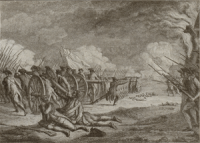|
Looking toward Meriam’s House from near the bridge crossing Mill Brook. 6/24/2012 4:55:09 PM
The Nathan Meriam House near Meriam’s Corner. 6/24/2012 4:59:24 PM
6/24/2012 4:56:56 PM
Memorial to the two British soldiers that died at Meriam’s Corner. 6/24/2012 4:58:13 PM
The British were in retreat by now after the Battle of North Bridge fighting a running battle to return to Boston. They met Minutemen as they tried to cross a small bridge over Mill Brook near the Meriam home along what is now referred to as Battle Road. The bridge forced a bottleneck because the number of soldiers that could cross was limited. From Miriam’s home, the Colonial Army opened fire on the soldiers killing two.
On April 18, 1775, General Thomas Gage sent Lieutenant Colonel Francis Smith with about 700 regulars from Boston to confiscate guns and ammunition rumored to be in Concord. The Revolutionary War began at Lexington on April 19th, 1775, when a small skirmish broke out between patriots and Colonel Smith’s men. Smith continued to move on toward Concord where they located a few cannon buried by the Colonial Army.
Colonel James Barrett commander of the Colonial Army with only 250 men surrendered the town of Concord to the approaching British and set up defenses outside of town on hills to the west of North Bridge. Smith ordered Captain Parsons to secure North Bridge while other British regulars searched the town. By the time the bridge was secured, Minutemen from around the countryside were swarming into the ranks of the Colonial Army after word spread of the fighting. There were more than 400 of them at North Bridge by the time the first shots were fired. The British decided to retreat back to Boston.
Near Meriam's Corner (named after the nearby Miriam home), the ranks of the Minutemen had swelled to more than 1000 as news of the Lexington and North Bridge engagements spread. Fighting at Meriam’s Corner resulted in 2 British regulars killed and 6 more wounded. When the British had retreated to a point now referred to as Bloody Angel, they met more than 200 Minutemen from Bedford and Lincoln well hidden behind trees and walls along the road. They caught the British in a classic crossfire killing about 30 British soldiers while losing only 4 Minutemen. The British soldiers broke into a fast jog and escaped because the Colonials could not keep up in the swamps and brush. There were additional skirmishes all along the route back toward Boston.
By this time, Gage received messages that his troops were under attack and sent more than a 1,000 regulars under the command of Earl Percy in support of Smith. Once Percy reached Smith’s men around Lexington he assumed command and marched back to Cambridge under continued harassment from Colonials. Meanwhile, Brigadier General William Heath arrived to take charge of the Colonial Army and instructed his men to attack from concealed positions and not engage directly.

The Battles of Lexington and Concord were the first military engagements of the American Revolutionary War. They were fought on April 19, 1775, in Middlesex County, Province of Massachusetts Bay, within the towns of Lexington, Concord, Lincoln, Menotomy (present-day Arlington), and Cambridge, near Boston. The battles marked the outbreak of open armed conflict between the Kingdom of Great Britain and its thirteen colonies in the mainland of British North America.






 Please share your ideas with us.
Please share your ideas with us.